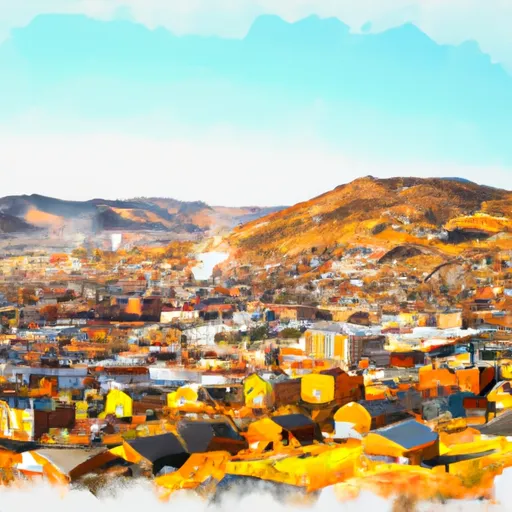-
 Snoflo Premium
Snoflo Premium
Get unlimited access to all our content
With no Ad interruptions! - Start Your Free Trial Login with existing account
Steamboat-Spring
Eden Index
Climate
7.0
•
Recreation
8.0
•
Community
4.3
•
Safeguard
6.7/10

Steamboat Springs, Colorado, located in the Yampa Valley, is renowned for its picturesque landscapes and abundant outdoor recreation opportunities. The town experiences a highland continental climate characterized by warm summers and cold winters. Summer temperatures average around 80°F (27°C), while winter temperatures can drop to an average of 10°F (-12°C). The region receives an average annual precipitation of 24 inches (61 cm), with snowfall being the primary source during winter.
The hydrology of Steamboat Springs is heavily influenced by the Yampa River, which flows through the town. The river provides ample opportunities for fishing, kayaking, and rafting. It is also a popular spot for tubing during the summer months. The area is also home to numerous hot springs, fueled by geothermal activity.
Outdoor recreation in Steamboat Springs is abundant year-round. In winter, the town is a winter sports paradise, with world-class skiing and snowboarding opportunities at the Steamboat Ski Resort. Cross-country skiing, snowshoeing, and snowmobiling are also popular activities. During the summer, visitors can enjoy hiking, mountain biking, horseback riding, and camping in the surrounding areas. Steamboat Lake State Park and Fish Creek Falls are popular destinations for outdoor enthusiasts looking to explore the beautiful nature of the region.
What is the Eden Index?
The Snoflo Eden Index serves as a comprehensive rating system for regions, evaluating their desirability through a holistic assessment of climate health, outdoor recreation opportunities, and natural disaster risk, acknowledging the profound impact of these factors on livability and well-being.
Climate Health Indicator (CHI): 7.0
Steamboat-Spring receives approximately
656mm of rain per year,
with humidity levels near 68%
and air temperatures averaging around
5°C.
Steamboat-Spring has a plant hardyness factor of
4, meaning
plants and agriculture in this region thrive during a short period during spring and early summer. Most
plants will die off during the colder winter months.
By considering the ideal temperature range, reliable water supplies, clean air, and stable seasonal rain or snowpacks, the Climate Health Indicator (CHI) underscores the significance of a healthy climate as the foundation for quality living.
A healthy climate is paramount for ensuring a high quality of life and livability in a region, fostering both physical well-being and environmental harmony. This can be characterized by ideal temperatures, reliable access to water supplies, clean air, and consistent seasonal rain or snowpacks.
Weather Forecast
Streamflow Conditions
White - Yampa
Area Rivers
White - Yampa
Snowpack Depths
White - Yampa
Reservoir Storage Capacity
White - Yampa
Groundwater Levels
Recreational Opportunity Index (ROI): 8.0
The Recreational Opportunity Index (ROI) recognizes the value of outdoor recreational options, such as parks, hiking trails, camping sites, and fishing spots, while acknowledging that climate plays a pivotal role in ensuring the comfort and consistency of these experiences.
Access to outdoor recreational opportunities, encompassing activities such as parks, hiking, camping, and fishing, is crucial for overall well-being, and the climate plays a pivotal role in enabling and enhancing these experiences, ensuring that individuals can engage in nature-based activities comfortably and consistently.
Camping Areas
| Campground | Campsites | Reservations | Toilets | Showers | Elevation |
|---|---|---|---|---|---|
| Catamount | None | 6,563 ft | |||
| Chapman Reservoir | 12 | 9,269 ft | |||
| Meadows | 30 | 9,288 ft | |||
| Lynx Pass | 11 | 8,987 ft | |||
| Pinball Point | None | 6,457 ft | |||
| Crosho Lake Recreation Area | 10 | 8,872 ft | |||
| Stagecoach State Park | 100 | 7,307 ft | |||
| Dry Lake | 8 | 8,279 ft | |||
| Walton Creek | 14 | 9,392 ft | |||
| Granite | 8 | 9,885 ft |
Nearby Ski Areas
Catastrophe Safeguard Index (CSI):
The Catastrophe Safeguard Index (CSI) recognizes that natural disaster risk, encompassing floods, fires, hurricanes, and tornadoes, can drastically affect safety and the overall appeal of an area.
The level of natural disaster risk in a region significantly affects safety and the overall livability, with climate change amplifying these risks by potentially increasing the frequency and intensity of events like floods, fires, hurricanes, and tornadoes, thereby posing substantial challenges to community resilience and well-being.
Community Resilience Indicator (CRI): 4.3
The Community Resilience Indicator (CRI) recognizes that education, healthcare, and socioeconomics are crucial to the well-being of a region. The CRI acknowledges the profound impact of these elements on residents' overall quality of life. By evaluating educational resources, healthcare accessibility, and economic inclusivity, the index captures the essential aspects that contribute to a thriving community, fostering resident satisfaction, equity, and social cohesion.

